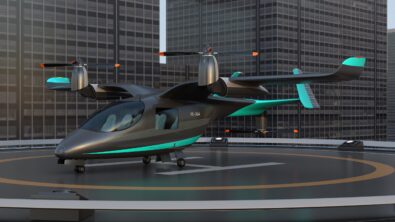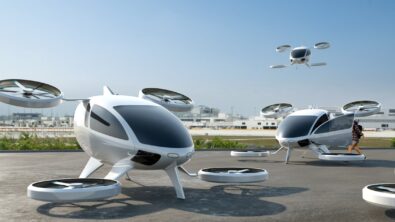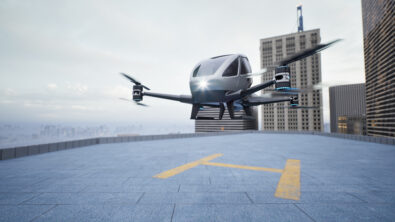Insights on AAM Autonomy from Automotive Part Two – Transcript

In this episode of Talking Aerospace Today, Todd Tuthill and Nand Kochhar continue their discussion on what advanced air mobility companies can learn from automotive about vehicle autonomy, focusing on cybersecurity, certification, and safety.
Patty Russo: Greetings and welcome to another episode of Talking Aerospace Today from Siemens Digital Industries Software. I’m Patty Russo and I manage marketing for our global aerospace and defense vertical here at Siemens. Thank you for tuning in today. In our last episode, we explored one of the key challenges that our industry will be facing relative to advanced air mobility, autonomy. Many companies are looking to make their designs of this new aircraft classification capable of autonomous flight without a human pilot. Of course, that comes with its own obstacles regarding technology, regulation, as well as cultural acceptance. Our VP of A&D, Todd Tuthill and I were joined for that discussion by Nand Kochhar, who is the VP of our Automotive and Transportation vertical here at Siemens.
Patty Russo: The automotive and transportation industry, obviously, already has plenty of experience making their vehicles autonomous. In that previous conversation, we defined the different levels of vehicle autonomy and identified some of the factors that raised challenges for the AAM industry and aerospace and defense, namely safety. Today, we’ll pick up that conversation for the second of three episodes, covering the topic of autonomous with Todd and Nand. So let’s jump right back in where we left off the last time.
Patty Russo: When it comes to the idea of autonomy, there’s another factor that we need to consider, and that is, so Todd, you mentioned the fact that air traffic control and the computers were trying to guide Sully in one direction, and he had to make a decision, human decision, on the, I’m going to use another pun, “on the fly.” Sorry, sorry.
Todd Tuthill: You just can’t help yourself, can you, Patty? That’s good. That’s funny.
Patty Russo: No, I still can’t help it, but he had to make a decision very quickly and so there’s one side of that input from the technology. The other side of that input is security and safety from another point of view, the cybersecurity aspect. So Nand, I’m going to ask you this question because of the, you know, further advanced that the automotive industry is. What does cybersecurity look like today when it comes to autonomous vehicles? There’s, basically they’re rolling computers, cars, these days. So how do you automotive companies keep quote unquote bad actors from taking over my car?
Nand Kochhar: Yeah, absolutely. You said it. Modern vehicles are computers on the wheel, so that means there’s a very heavy application of electronics and software on that electronics. So that’s bringing together cross domain of electrical electronics and software all together. So the moment you bring in that aspect of it, you need to design in the safety, not only just validate for safety. So in automotive industry, acceptance of the new standards around let’s say ISO 26262 on the software development standards, they have become very, very important in terms of making sure that design of that software and electronics is being done from a cybersecurity standpoint.
Nand Kochhar: After that, once you’ve got that software built in, in the vehicle for driving, it becomes just like your normal IT infrastructure. You need to protect it for just like you protect from cybersecurity your mainframe servers in the IT organizations. Now you need to be protecting the computer in the vehicle the same way from a cybersecurity perspective so that, as you mentioned, the bad actors are not able to act on it and take control over those things. So it’s very common analogy of managing your IT infrastructure and the manufacturing company and in the banking industry. Now you’ve got that in the vehicle as a software. So cybersecurity is equally important as that aspect as well.
Patty Russo: Yeah and I suspect that in the aerospace and defense industry, that’s obviously something that has been top of mind for quite some time, especially as it pertains to what Todd had referenced is that aircraft, at least on the commercial side, have been operating somewhat autonomously for quite some time. And related to safety though, in the cybersecurity side of it that brings up, you know, other issues and other concerns when it comes to the defense side of the industry when they decide to adopt the AAM type of aircraft. But when it comes to all of that, what we’re talking about is adding just one more layer when it comes to certification.
Patty Russo: The reason that the aerospace and defense industry and I trust, similarly in the automotive industry, the reason it is at least aerospace and defense is very safe because of certification and it’s a major consideration for, you know, all industries whether it’s you know, consumer electronics or automotive or aerospace. However, with aerospace it’s a matter of public image, you know. Even if there’s, you know, the Sully example is a good one. He, you know, that could have ended a lot differently and would have changed, I’m sure the course of the industry for years to come, but certification considerations when it comes to this autonomous factor definitely has to be something that is concerning when it comes to certifying this new class of aerial vehicles, whether it’s the FAA in the US or local regulatory entities in other countries, they have to balance that safety side of the equation with efficiency and getting the aircraft designed and manufactured and in use.
Patty Russo: So adding autonomy to AM vehicles that carry passengers that are pilotless or crewless adds just one more level of complexity. So Nand, this question is for you. How has the automotive industry struck that balance and approached the issues of the regulatory process and the certifications validations when it comes to autonomous vehicles?
Nand Kochhar: Absolutely. So as you know, on the regulation side of certification, there’s no regulations for the fully autonomous vehicles. So the industry has been working with the organizations like in the US National Highway Traffic Safety Administration, which monitors all of the crash safety standards. Working with those organizations and improving how companies have been doing verification and validation of ADAS features they are offering, advanced driver assist systems, and then coming to an acceptability level by proving that what all different conditions have been. Testing. So that’s how they get that certification for releasing that function, our feature function in the vehicle.
Nand Kochhar: So the good example is in Europe. We have a euro end CAP, which is the new card model assessment program. They give the star ratings of a vehicle which is for a crash. It’s a five-star, four-star, etc. Now they’ve started to build in the credits for any of the advanced driver assist features. So if you’ve got an adaptive cruise control, emergency braking systems.
Nand Kochhar: So you do get credits towards that star rating and the certifications and the other example would be what I just touched on, within the US certain states have opened up their certification processes working with companies to define what level of vehicles they can sell for public roads in those areas. So once again use Nevada as an example, where one of the European major OEMs company worked with the agencies and deliver a certain level of autonomy for those vehicles to be driven on public roads. So that’s how it is building while the policymakers and the consumers all come to synergies of what those regulations need to be. So this is how auto industry has been progressing to different levels of autonomy or the autonomous features.
Todd Tuthill: You know, Nand if I could, I’ve been thinking about something Patty said relative to the auto industry and their industry relative to cybersecurity. And I’m going to ask a question because I just honestly don’t know the answer. If you think about these autonomous Ubers, do we have today. Who tells these Ubers where to go? Is it just the app that I sent it to or is there somebody, is there Big Brother watching over those Ubers all the time, some control center?
Nand Kochhar: That’s very good question, Todd. One of the levels is a level four. The constraint and the level four could be vehicles being driven autonomously, but it is remotely monitored and in fact you will come across that example in a lot of the school campuses in several locations in certain cities. They will have that. We have that one in Michigan as well in the past where vehicles are being monitored remotely so that in in case anything goes not as expected. So there’s remote monitoring is the constraint which makes it a level four and not a level five in this example.
Todd Tuthill: If I could, because that, because again, I want to make that analogy to what’s happening in aerospace, because if you think about what, where the advanced air mobility companies are going, there’s a company called Wisk that’s doing something very interesting. Most of the air mobility companies are, their first offering, their first certification is actually going to be with a pile. So they’re going to have to have that paid trained pilot in there taking away a paying passenger seat. Wisk is doing something different. They’re doing what Nan would define as a level four and there is going to be a command center where a real person is controlling three aircraft, four aircraft, six aircraft.
Todd Tuthill: But the interesting thing is that’s their plan. But because of, you know, we talked about certification and safety. One of the things you’ve got to build into aircraft or automobiles or anything when you design something has people in it, you’ve got to have think about redundancy and what happens in a bad day. And one of the key things we’ve got to think about for advanced air mobility aircraft is if I lose that command and control link, you know that’s causing it to be a level four that, advanced air mobility all of a sudden becomes a level five. And it’s got to be able to fly to a given location, a safe location and land itself.
Todd Tuthill: And if you think about what I said in the beginning in terms of aircraft today, one of the areas where you typically have a human involved is in landing. So if you think about from a safety standpoint, from a cybersecurity standpoint, from a certification standpoint, the hurdle that Wisk and other companies have to get over to get that aircraft certified, they got to do all this stuff at level four, make sure it’s safe for a human controller to put it in this right place. But then they have to say, “If I lose that command and control link,” because that is possible, “what happens to that aircraft?” So essentially they’ve got to go ahead and test and prove that in a level five full autonomy that aircraft is always going to do the safe thing. And that’s again one of the things I think that differentiates maybe the bar that you got to get to an air mobility aircraft, maybe from where we’re at with the Ubers now for cars.
Patty Russo: Yeah, for sure. And tangentially related to that, the question that came to mind when both of you were talking is the time for certification. So in aerospace and defense, it could be up to 10 years, if I’m not mistaken, to certify an aircraft and. In some cases, it’s upwards of 50 to 75% of the cost and time to certify versus design in the aerospace and defense industry. Nand how long does it take from design of a new concept to that vehicle being in use, is in the automotive industry? I’m just curious, the comparison of, you know in terms of certification or verification processes to get that vehicle out the door and on the street.
Nand Kochhar: Yeah, I think I’ll give a range. Obviously, it is much shorter than the aerospace numbers you just shared and in automotive, it depends on the size of the program or is it brand new architecture and a brand new vehicle or is it a carryover architecture and the new model of a certain vehicles drives the overall product development time and hence the certification and the complete delivery time. But typically I would say industry, and it varies from OEM to OEM, how many of those original equipment manufacturers all over the globe have been on a digital transformation journey type of thing and things they can do faster. Are they still in this physical testing development environment?
Nand Kochhar: But typically I would say is 36 months would be that in the middle of the road type of line. Obviously there are companies out there. It used to be a 60 month process and we have been constantly bringing it down and we have worked with some of our customers who are in this other extreme efficient and with up to 18 months of product development process. So you see there’s a big, big variation, but both of those numbers are smaller than, from the aerospace comparison perspective.
Patty Russo: Thank you, Nand for those insights and your expertise, and Todd to you as well. We’ll wrap it up here for now, but we’ll be back in the next episode to pick up the discussion about autonomy and advanced air mobility. And again, thank you to our listeners for joining us. We invite you to catch the third and final part of the discussion on this topic in our next episode. I’m Patty Russo and this is Talking Aerospace Today.
Siemens Digital Industries Software helps organizations of all sizes digitally transform using software, hardware and services from the Siemens Xcelerator business platform. Siemens’ software and the comprehensive digital twin enable companies to optimize their design, engineering and manufacturing processes to turn today’s ideas into the sustainable products of the future. From chips to entire systems, from product to process, across all industries. Siemens Digital Industries Software – Accelerating transformation.


